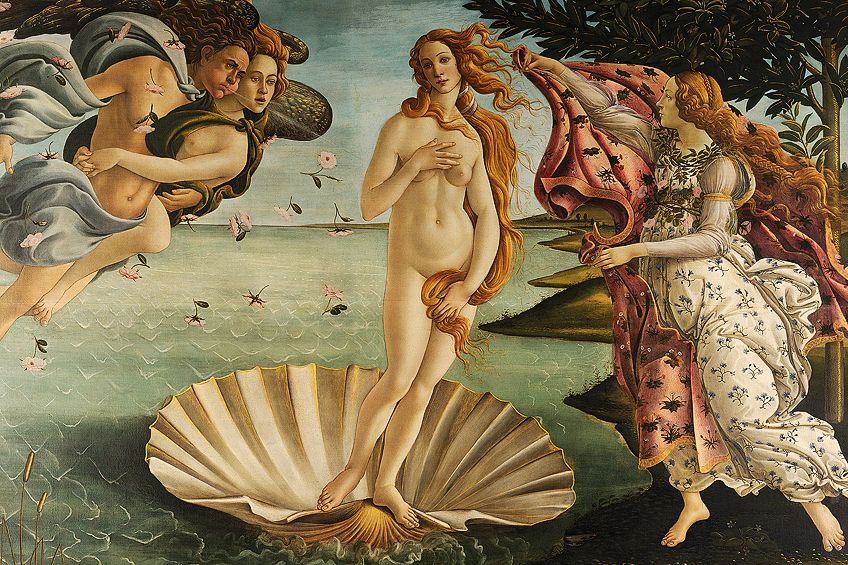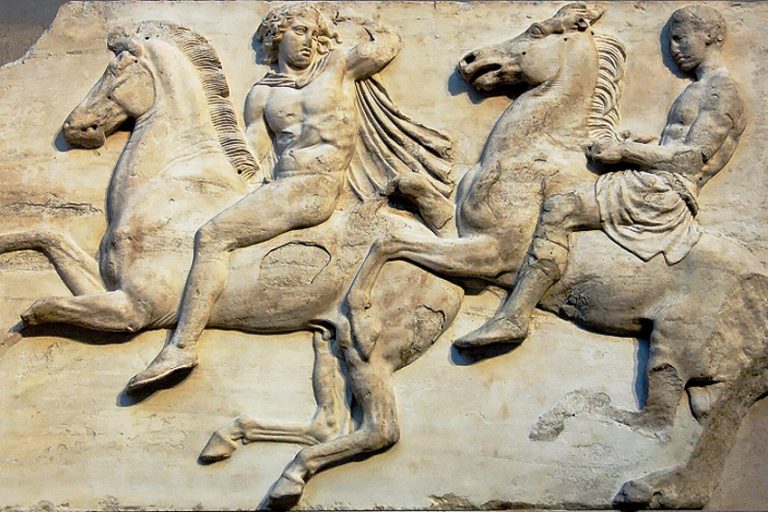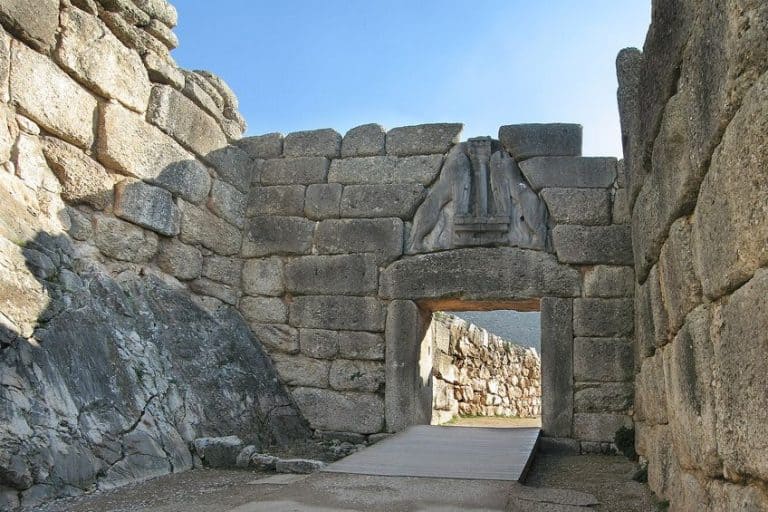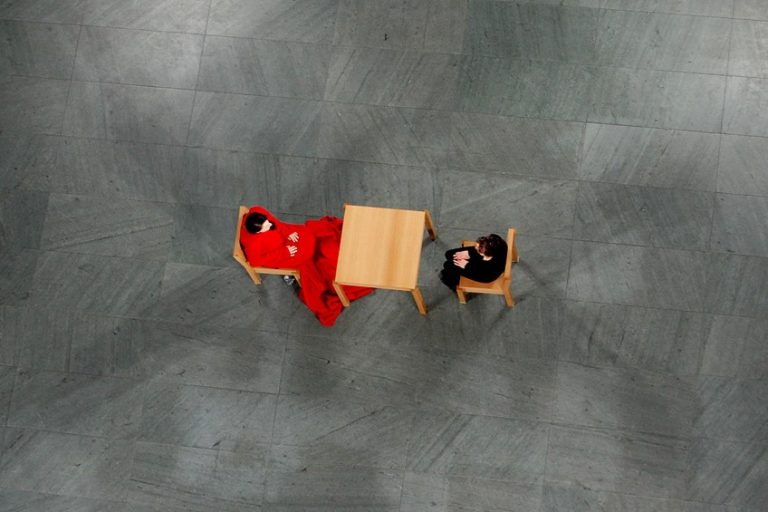Early Renaissance – Exploring the Early Italian Renaissance Art Period
The Early Renaissance time period was the start of a cultural rebirth in Italy. It was a time in the history of most of Europe when the visual arts radically evolved from two-dimensions to three-dimensions, quite literally and figuratively. This article will discuss what made the art from the Early Renaissance so unique and burgeoning with possibilities for the future. We will also explore some of the main characteristics and important artists of this time.
Early Renaissance: Starting in Florence
Early Renaissance art occurred during the 1400s (15th Century CE), more specifically from 1400 to 1495 CE. This period was also known as Quattrocento, which means “400” in Italian. It originates from the Italian word millequattrocento, meaning “1400” (Mille means one thousand in Italian). Before we begin, let us take a look at Florence, the cultural capital of early Italian Renaissance art. This will also give us an understanding of the state and shape of Italy during this time and how the visual arts evolved.

Florence became the cultural capital of the visual arts in Italy, which would eventually spread across Europe. However, these cultural developments were preceded by considerable economic and political upheavals. This was also the time of the Middle Ages and the Gothic Art movement.
There were two important events that led to the Early Renaissance, being the Fall of Rome (or the Western Roman Empire) during 476 CE and the Middle Ages, which occurred as a gradual shift in European society. This eventually led to the Proto-Renaissance (Pre-Renaissance), followed by the Early Renaissance.
While an extensive historical account of all the events leading up to the Early Renaissance will certainly provide a holistic context, the important thing to remember is that during the Late Middle Ages, Italy was in a state of division. In other words, it consisted of numerous city- or nation-states, namely, Florence, Milan, Naples, Rome, and Venice.
There was an increase in trade with more merchants holding power and wealth. Money also became the primary means of exchange, replacing feudalism and fiefdom. Additionally, many serfs were also freed from their lives of servitude and debt. There was an overall shift in economic and societal power and structure.
Florence, as one of the individual city-states in Italy, was ruled by wealthy middle- and upper-class merchants (think shop owners) and bankers. Important families like the Medici family were also wealthy patrons of art during this time. It was a hub of high-quality goods and a high-quality perception of self, including the perception of the divine.

Florence also offered its citizens more freedom as it was a republic, and included citizens within the governmental structures. With an increase in liberty and personal power, the city became known as the “New Athens”. It held itself in high regard, on par with the ideals of the classical Roman Empire. The values of Classical Antiquity were also reshaped and revisited within the visual arts and philosophical beliefs.
With this expansiveness and freedom, there was an increasing development in how people viewed themselves in relation to the universe. A new philosophy called Humanism emerged throughout Italy, placing man at the center of the world, so to say. People still worshipped God and remained devoted to Christianity, but the difference was the importance placed on man’s greatness and effigy. For example, visual imagery like paintings or sculptures that venerated religious or saintly figures, as well as biblical narratives, would depict the human form in astute anatomical detail.
In other words, this focus on depicting the human form realistically became wholly different to the more idealized depictions seen from prior art periods like Byzantine art. There was an increased three-dimensionality versus the two-dimensionality of prior art periods.
It was a revolutionary time in culture and the visual arts. New techniques emerged that changed the shape – literally and figuratively – of how art related to the world. In fact, the Renaissance is the Italian word for “rebirth”. It was certainly a rebirth in culture, arts, politics, economics, science, and society within Europe.

Early Renaissance Art
It is worthwhile exploring how the visual arts evolved in Florence as the cultural center of Italy during the Early Renaissance. First, let us discuss a few of the important artists that paved the way in Pre-Renaissance artwork. We will then explore some of the common characteristics of Early Renaissance art and important artists from this period.
Pre-Renaissance Artwork
The Pre-Renaissance is also called Proto-Renaissance, which occurred during the 1300s (14th Century CE). It was also called the trecento period, meaning “300” in Italian. This period also included the Gothic Art style, more so the later International Gothic style, and the Sienese School of Painting.
Byzantine art was the dominant art style during this time, where artworks were depicted with more two-dimensionality, flatter planes, and idealized forms.
There were two important Italian artists during this time, namely, Cimabue (also known as Cenna di Peppi) and Giotto di Bondone. Both artists started portraying more “figurative realism” in their Byzantine-style art. For example, the human figure had more anatomical detail and a heightened sense of naturalism. This in turn created more expressiveness of the subject matter, an example of which is depicted in the crucified body of Christ in Cimabue’s Santa Croce Crucifixion (1287 to 1288).

Giotto became a revolutionary artist for his time because he started incorporating more “humanism” in his frescoes versus the “flat”, less personal depictions of figures. He was called the “Father of Painting” by the famous Renaissance historian, writer, and artist Giorgio Vasari in his seminal publication called the Lives of the Most Eminent Painters, Sculptors, and Architects (1550).
We see this in Giotto’s famous fresco titled Lamentation (The Mourning of Christ) (1304 to 1306). Giotto creates three-dimensionality in his fundamental use of perspective and foreshortening, which is seen in the receding procession of people to the left of the composition. He also creates more emotive expressions through the facial features and body language of the figures and angels around and above the dead body of Christ.
Characteristics of Early Renaissance Art
Giotto’s frescoes and style ushered in a new way of painting and conceptualizing a composition. As a leading Florentine painter, he led the way for Early Renaissance art to take on an entirely new style. What, then, were the characteristics of Early Renaissance art exactly?
Some of the major characteristics of Early Renaissance art focused on realism and naturalism in the way figures were portrayed. There was an increase in depth and dimensionality to create the sense of space. This was achieved by utilizing techniques like foreshortening and one-point perspective.
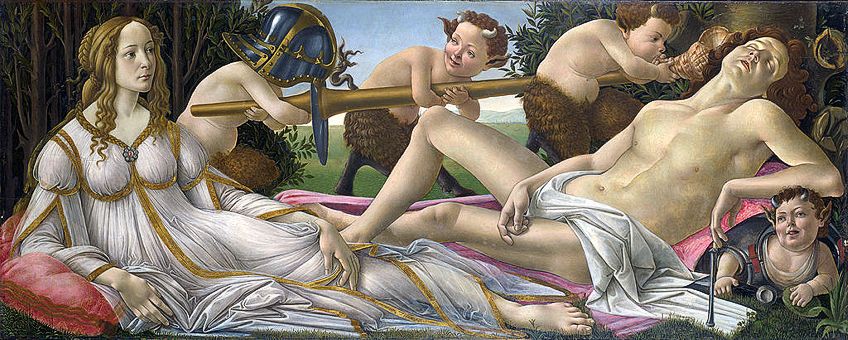
Color and contrast also created more realism and dramatic emphasis, achieved in techniques like chiaroscuro, which focused on shading between light and dark areas to create depth. While these techniques started developing during this period, they became more honed during the succeeding High Renaissance period.
Subject matter became more diverse, not merely restricted to religious and biblical figures. Artists started to depict mythological figures from Classical Greece and Roman narratives in their compositions. The return to mythological narratives was not considered pagan as it used to be during the Medieval period.
Early Renaissance Artists
There were three artists regarded as the forerunners during the Early Renaissance time period. In painting it was Masaccio, in architecture it was Brunelleschi, and in sculpture it was Donatello. However, there were numerous other artists highly regarded for their artistic contributions and innovations. Below, we explore some of the famous Early Renaissance artists and their journeys in bringing new methods to what was known as the “Age of Enlightenment”.
Filippo Brunelleschi (1377 – 1446)
Brunelleschi was an important architect during the Early Renaissance because of his extensive studies in Roman architecture, as well as the mathematical theories of perspective and proportion from Vitruvius, the Roman architect and author from the 1st Century BCE. Brunelleschi influenced many artists and architects with his innovative new architectural designs, including Leonardo da Vinci from the later High Renaissance period. One of his most important and influential buildings includes the Cathedral di Santa Maria del Fiore (1296 to 1436).
Although this cathedral was started by the designs of architect Arnolfo di Cambio in 1296, in the typical Gothic style, it was Brunelleschi who engineered the innovative solutions for the dome, which was completed around 1434 to 1436.

With his extensive studies in Classical theories, he managed to design and build the dome with inner and outer reinforcements to prevent the dome from falling in on itself atop the octagonal-shaped church. Brunelleschi also designed a unique crane and hoist to assist him in the building process, further demonstrating his adept skill and understanding of architecture and engineering.
For the city of Florence, this cathedral was and still is an important landmark. As one of the largest churches in Italy, it is symbolic of the city’s grandeur, emulating the classical virtues of proportion and harmony. It goes without saying that it also emulates the architectural genius behind the structure’s design. The dome, made from red brick, is also one of the largest domes constructed, measuring at around 372 feet. Today, it is a UNESCO World Heritage Site.
Donatello (1386 – 1466)
Donato di Niccolò di Betto Bardi, or just Donatello, was a Florentine sculptor and close friend of Brunelleschi’s. In fact, both artists traveled to Rome and studied ancient classical architecture and sculptures from various sites there. Donatello created numerous sculptural masterpieces in his day, but some of the more common ones include his bronze sculpture titled David (1440 to1443) and the Penitent Magdalene (c. 1453 to 1455).
David is one of Donatello’s most famous bronze sculptures. It measures five feet tall and is one of the first free-standing nude sculptures of a male figure (nude sculptures were created during the Classic Era). This also contrasts with sculptures from the Gothic Era, which were attached to the entrances of cathedral buildings.

It depicts the biblical figure of David with Goliath’s head between his legs. He holds a long sword in his right hand, a hat with a laurel wreath on his head, and boots that appear adorned with decorative detailing. He also stands in the classical contrapposto stance, resting most of his body weight on his right leg. His left leg is more relaxed making him appear more at ease. This adds to the overall dynamism of the sculpture, giving it a heightened sense of realism.
Donatello also innovated and applied a new relief technique in his sculptural works referred to as relieve schiacciato, which involves a gradual thinning of the relief, from foreground to background. This technique offered more three-dimensionality, giving a keener sense of depth.
He also included linear perspective to create a sense of depth. An example of this is in the bronze relief titled Feast of Herod (1423 to 1427). Here we see two groups of people on the left and right. There is an empty space between them. The perspective here suggests that of a “V” shape. Donatello uses orthogonal and transversal lines of perspective to draw the eye along the composition, making it appear more three-dimensional.
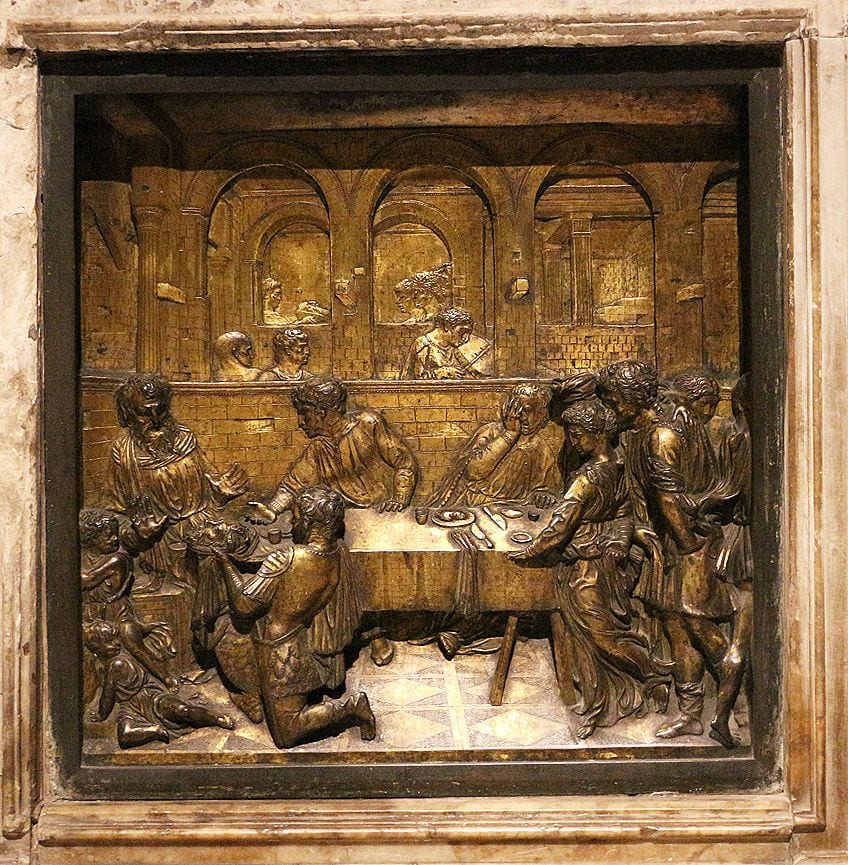
Masaccio (1401 – 1428)
Tommaso di Ser Giovanni di Simone, or just known as Masaccio, was one of the forefathers of Early Renaissance painting. He drew inspiration from Brunelleschi’s founding and application of the theories of perspective, incorporating linear perspective into his paintings creating more three-dimensionality.
Furthermore, he portrayed his subject matter with a deeper sense of realism and naturalism, also influencing many other Renaissance artists like Piero della Francesca, Leonardo da Vinci, Michelangelo, and Raphael because of this. His artwork truly created a ripple effect across the Renaissance art period and beyond.
Among some of his common artworks are San Giovenale Triptych (1422), Madonna and Child with St. Anne (1424 to 1425), Tribute Money (1425 to 1427), Expulsion from Eden (1425 to 1427), and The Trinity (1427 to 1428).

Tribute Money is one of Masaccio’s most popular artworks and a rich portrayal of his artistic mastery. It depicts the story of Christ and his disciples paying their taxes in Capernaum. The narrative is also set in three stages: We see Peter kneeling on the left side taking pieces of gold from the fish, Christ and his followers are in the center, and Peter is paying the tax collector on the right side.
The receding mountains in the background and the building in the foreground suggest Masaccio’s utilization of linear perspective, creating a sense of three-dimensionality. Masaccio created realism with this work unlike many others before him because of it not being a mere two-dimensional picture plane.
Furthermore, the way the figures wear their robes and their stances are reminiscent of figures like philosophers from the Classical Era. There is also a focus on the appearance of the figures and composition more so than the actual storyline being portrayed.
Piero della Francesca (1420 – 1492)
Piero della Francesca is another great artist from the Early Renaissance. He also mastered techniques like linear perspective and gave his figures a Classical resemblance while depicting biblical narratives. This situated his artworks with the likes of Masaccio and Brunelleschi.
One of his more famous artworks is the Flagellation of Christ (c. 1455). This is a scene where we clearly see the distinction between the foreground and background, suggesting a skilled portrayal of perspective and foreshortening by the artist. In the background to the left, we see Christ tethered to what appears to be a free-standing column with a golden statue at the top. He is being whipped by a Roman with three others surrounding him.
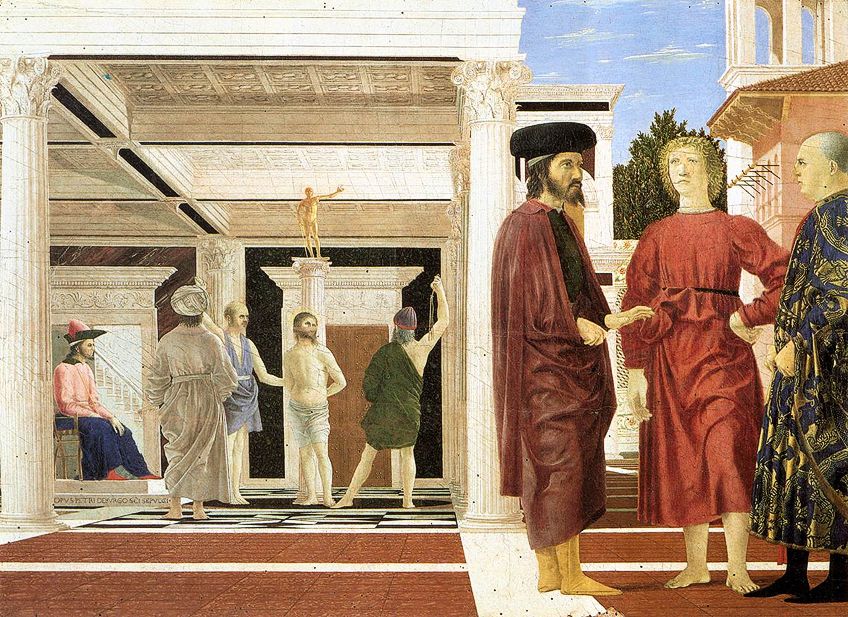
In the foreground, we see three figures to the right appearing to have an in-depth conversation, oblivious to what is occurring in the background. The whole composition is seemingly split into two scenes by the perspective lines created from the tiling and columns. We see this in the thick vertical white columnar-like line, almost like an extension of the column in the center of the composition, just behind the frontal figure to the left. This further indicates a three-dimensionality because we see the gap created between the frontal left figure and the column behind him, indicating spatial awareness.
We also notice two different sets and patterns of tiles, suggesting the background is the interior space and the foreground is the exterior space. When we look at the architectural space, the scene in the background is also seemingly framed by the two Corinthian Order columns along the central horizon line of the composition. The ceiling is also portrayed in architecturally decorative squares and right across from this interior space we notice what appears to be a red brick building.
The whole scene has a mysterious quality, yet it is portrayed with a keen observance of perspectival and spatial laws.
Other works by Francesca include The Baptism of Christ (c. 1448 to 1450), The Death of Adam (1452 to 1466), and The Resurrection (1460 to 1465). In all three of the above-mentioned works, we see the artist’s handiwork at portraying the illusion of space, and the interplay between foreground, background, and various narratives in one composition.
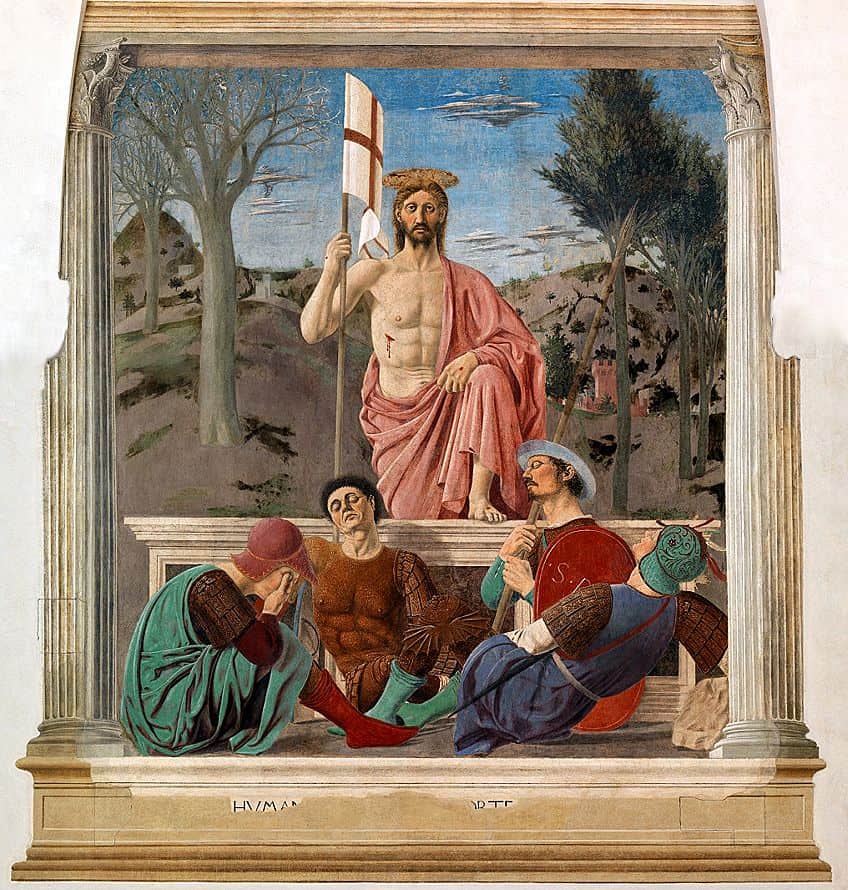
The Resurrection seemingly invites us, the viewers, into the scene. We see Christ standing prominently as the central figure, holding a flag in his right hand. There is a landscape in the background with trees on either side, almost framing the figure of Christ. A contrasting effect is created between Christ, staring right at us, and the four sleeping Roman soldiers in the foreground.
Additionally, Christ stands with his left leg up and foot resting on the tomb, which is between him and the four Roman soldiers. The tombstone seemingly creates a horizontal delineation between the foreground and background, further accentuating the entire verticality of the composition and Christ’s upright dominance. This also makes up a pyramidal shape.
The soldiers are clad in modern Roman attire, which makes the subject matter more relatable to the viewers, especially viewers from the time in which this painting was created. This can also create a contrasting effect between Francesca and other artists who portrayed figures more in line with Classical Antiquity.
Sandro Botticelli (1445 – 1510)
Alessandro di Mariano di Vanni Filipepi, or just Sandro Botticelli, had a different style to other artists of the time. He pioneered certain aspects like the inclusion of more secular subject matter like mythological scenes and characters.
While he portrayed the characteristic ideals of Humanism in his paintings, with a keen eye to perspective and the anatomical correctness of the human form, he also depicted a more decorative style with this.
The underlying impetus for this decorative style was to depict beauty, and this often led to the artist sacrificing proportion and symmetry to relay the idea of beauty better. His figures are also said to have a deeper emotional expressiveness that makes them more “relatable” with the viewer versus the idealized and often impersonal iconographic art of the Medieval Age. Some of Botticelli’s famous artworks include La Primavera (1477 to 1482), Venus and Mars (c.1482), and The Birth of Venus (c. 1486).

All three paintings depict mythological scenes of the Greek goddess Venus. When we look at the figures portrayed, we notice more symbolism and a focus on beauty portrayed rather than realism. This is evident in the seemingly elongated limbs of the figures, for example, Venus’s body in The Birth of Venus. Furthermore, Venus’s body is standing on the edge of a shell, appearing almost as light as a feather in her stance, which further indicates the lack of realism, but more symbolic beauty.
One of Botticelli’s earlier paintings, the Adoration of the Magi (c. 1475), is a depiction of the Medici family, with the artist himself standing on the extreme right corner in the foreground of the painting. What is notable about this painting are the architectural ruins making up the scene in the background. These are reminiscent of Classical Antiquity, suggesting a return to harmony and beauty during the Greek and Roman times. The ruins could possibly be symbolic of these times, which is a further testament to Botticelli’s style, shifting his focus away from depicting subject matter as true to nature.
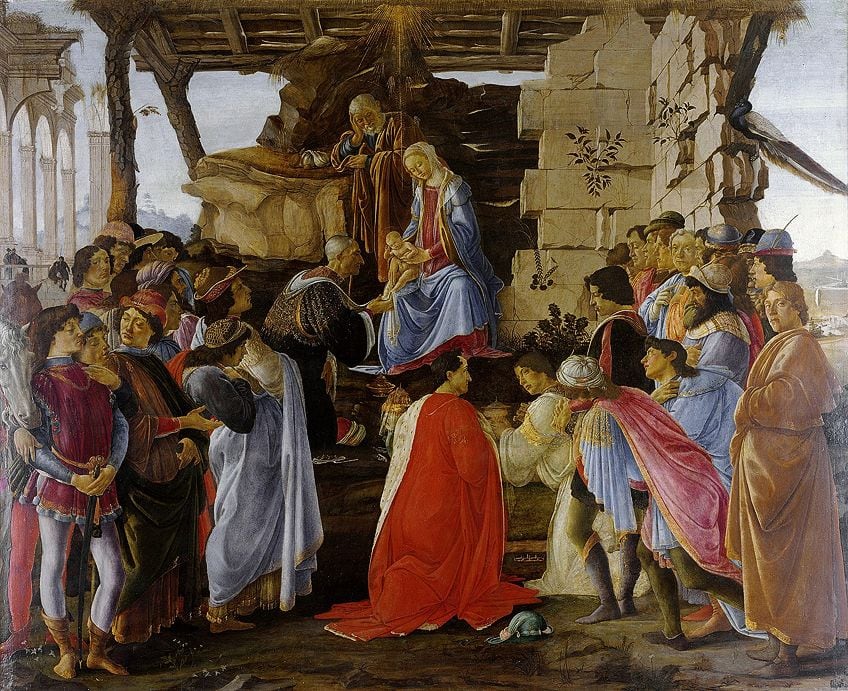
Higher Perspectives: Towards a More Refined Palate
The Early Renaissance developed into the High Renaissance, which continued in the spirit of Humanism and the portrayal of more naturalistic subject matter. Artists during the High Renaissance took the above-mentioned techniques from the Early Renaissance and refined them even further to produce artworks that would stand the tests of time and be immortalized for centuries to come.
Three great artists came from the High Renaissance period, namely, Leonardo da Vinci, Michelangelo, and Raphael. There were many other artists during this time who mastered new techniques like sfumato and quadratura. While the Early Renaissance occurred mainly in Florence as the central artistic hub, the High Renaissance took place primarily in Rome, run by the Pope. Many artists were commissioned by the Pope in his attempts to rebuild the city to its glory.
The Early Renaissance was a period in Europe’s history that built a new bridge between art and people. It made art visually accessible and relatable in different ways to how art was presented during the Medieval Age. This burgeoning breath of life revived Classical Antiquity in the arts and redefined arts beyond the structures of Romanesque and Gothic.
Frequently Asked Questions
When Was the Early Renaissance?
The Early Renaissance time period was during the 1400s (15th Century CE), taking place from 1400 to 1495 CE. It is also referred to as the Quattrocento period, which means “400” in Italian.
What Are the Main Characteristics of the Early Renaissance?
Early Renaissance art focused on realism, which was in line with the Humanism ideals prevalent during this cultural shift in European history. There was more naturalism in art. Figures were depicted with more anatomical realism and emotive qualities versus the two-dimensionality of the earlier Byzantine Art. Artists also included new illusionistic techniques like chiaroscuro and trompe l’oeil that contributed to the overall three-dimensionality of artworks.
Who Were Some Famous Early Renaissance Artists?
Although there were many great Early Renaissance artists, the more famous ones were Masaccio, who pioneered new techniques in painting, Brunelleschi, who pioneered linear perspective in architecture and inspired many other artists to come, and Donatello, one of the prominent sculptors. Donatello also traveled with Brunelleschi to ancient classical ruins, which informed and influenced many of their artworks.
What Were the Main Techniques Used During the Early Renaissance?
Some of the main techniques utilized during the Early Renaissance created overall three-dimensionality and realism. These techniques were used as color contrasts like chiaroscuro, which involved gradual shifts from dark to light. Linear perspective and foreshortening were used to create the illusion of space allowing the viewer to feel more immersed in the painting. Other techniques involved in sculpture included relieve schiacciato, which was a gradual thinning of the already utilized bas-relief techniques, creating more depth.
Isabella studied at the University of Cape Town in South Africa and graduated with a Bachelor of Arts majoring in English Literature & Language and Psychology. Throughout her undergraduate years, she took Art History as an additional subject and absolutely loved it. Building on from her art history knowledge that began in high school, art has always been a particular area of fascination for her. From learning about artworks previously unknown to her, or sharpening her existing understanding of specific works, the ability to continue learning within this interesting sphere excites her greatly.
Her focal points of interest in art history encompass profiling specific artists and art movements, as it is these areas where she is able to really dig deep into the rich narrative of the art world. Additionally, she particularly enjoys exploring the different artistic styles of the 20th century, as well as the important impact that female artists have had on the development of art history.
Learn more about Isabella Meyer and the Art in Context Team.
Cite this Article
Isabella, Meyer, “Early Renaissance – Exploring the Early Italian Renaissance Art Period.” Art in Context. June 15, 2021. URL: https://artincontext.org/early-renaissance/
Meyer, I. (2021, 15 June). Early Renaissance – Exploring the Early Italian Renaissance Art Period. Art in Context. https://artincontext.org/early-renaissance/
Meyer, Isabella. “Early Renaissance – Exploring the Early Italian Renaissance Art Period.” Art in Context, June 15, 2021. https://artincontext.org/early-renaissance/.


